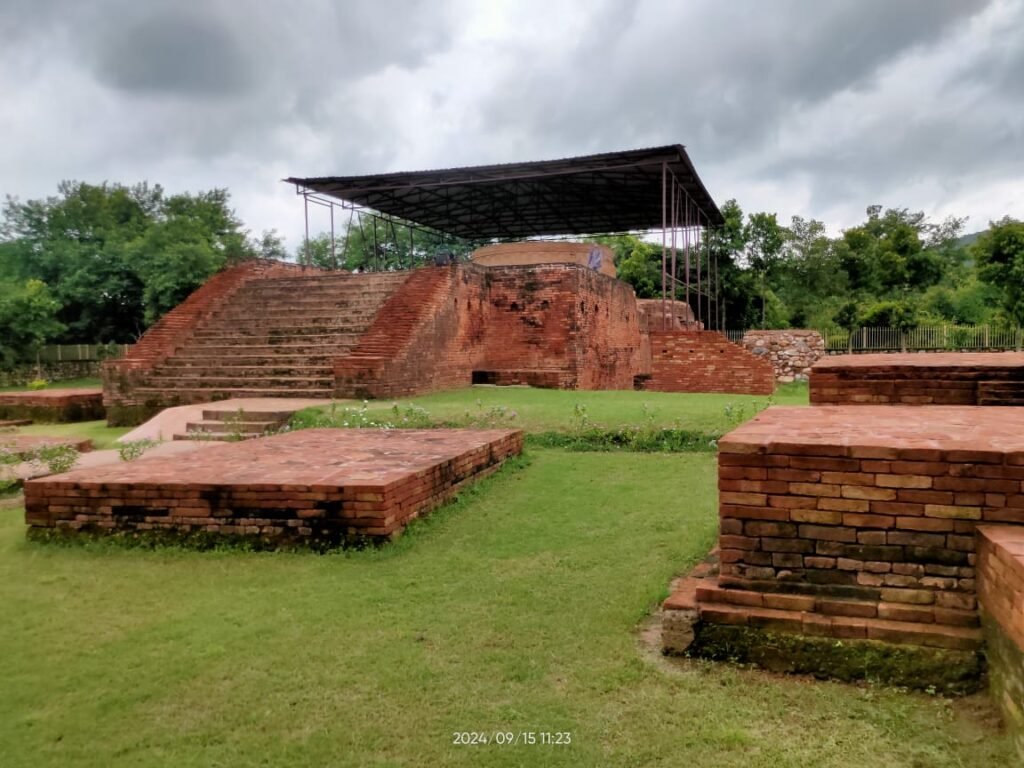Here’s Rajgir’s Maniyar Math travelogue written by travellers Pragati Bakshi and Rituraj Akhouri. Unfold the history and Learn about their experiences of exploring the culture-rich destination of Bihar!

Rajgir is a place of glorious culture extending beyond spatial boundaries and encompassing different layers of time. Surrounded by five hills named Ratnagiri, Vipalachal, Vaibhagiri, Songiri and Udaygiri, Rajgir is endowed with nature bounties in the form of green canopies of trees and large ponds studded with lotus and water lily flowers. One of its ancient sobriquets, Kusagrapur was derived from the white feather-like flowers that bloom in abundance during the post-monsoon season as a harbinger of autumn and winter. Rajgir was the capital of the mighty Magadh empire fortified by hills. Among the mythical personalities of Rajagriha King Vasu, the fourth son of Brahma supposedly the founder of the city, Brihadratha the progenitor of the Barhadratha dynasty and Jarasandha a mighty king of his
time, are names of the great kings who ruled the land.
Bhagwan Buddha and Bhagwan Mahavira spent time at Rajgir during the reigns of Bimbisara and Ajatsatru in the sixth and fifth centuries BCE. In one of the texts by Hiuen Tsang, it was documented that Rajgir was ruled by 32 mighty monarchs prior to the reign of Ajatshatru. The city was fortified by Cyclopean walls that stood high and mighty on the surrounding five hills that enveloped the place.
One of the most mysterious monuments excavated in Rajgir is the Maniyar Math, located almost at the centre of the old city of Rajgrih. In Mahabharat, it is identified as the shrine of Mani Nag. In the Pali text, this magnificent structure is referred to as Manimala-Chaitya. Many archaeologists have admitted that the present visible structure owing to its unique art style points its antiquity to the Gupta Period.
ALSO READ: The Majestic and The Magnificent Kesariya Stupa
The Main and Minor Edifice of Maniyar Math
The main edifice of Maniyar Math is a well-like structure made of 1.20 metres thick wall, with a diameter of approximately 3.00 metres. The exterior provides niches containing stucco images. A linga decorated with garland, four-armed Vishnu, Nagi image, idol of six-armed dancing Shiva and rather a rare image of Ganesh, with the body twisted with serpents. The main cylindrical-like structure resembles a Buddhist Stupa acknowledging the influence of Buddhism in religion and rituals. The minor structures like alters, platforms and shrines, etc scattered around were constructed probably for religious and ritual purposes prevalent among the serpent-worshipping cult during that era. The premises opened for visitors are distinct by several spherical and square platform-like structures probably used by priests for performing rituals. The three small spherical ditch-like constructions as locals say are storage for havan material for performing rituals related to Serpent worship. Among antiquities, a fragmentary sculpture of first-second century A.D. made of spotted Mathura sandstone carved on both sides is quite significant which depicts Naga and Nagi figures with serpent hood and the name “Mani-naga‟ below a Naga figure. Besides, several terracotta serpent hoods, multi-spouted pots and other minor objects related to rituals have been found at these excavation sites. All these artefacts are well preserved at Nalanda Museum.
How to Reach Rajgir
Rajgir is a block under the district of Nalanda in the state of Bihar. It is well connected with national highways, and train routes. From the capital city of Patna, the approximate distance to Rajgir is 100 km. Several trains shuttle between both destinations. Besides various tourist buses and cabs conveniently enroute towards the place. Rajgir being a popular tourist destination provides accommodations to tourists according to diverse budgets at their disposal.
ALSO READ: Sarnath – The Place Where Many Nations Converge with a Single Faith!
ALSO READ: Bali, Breeze on the Face, Salt in the Hair
